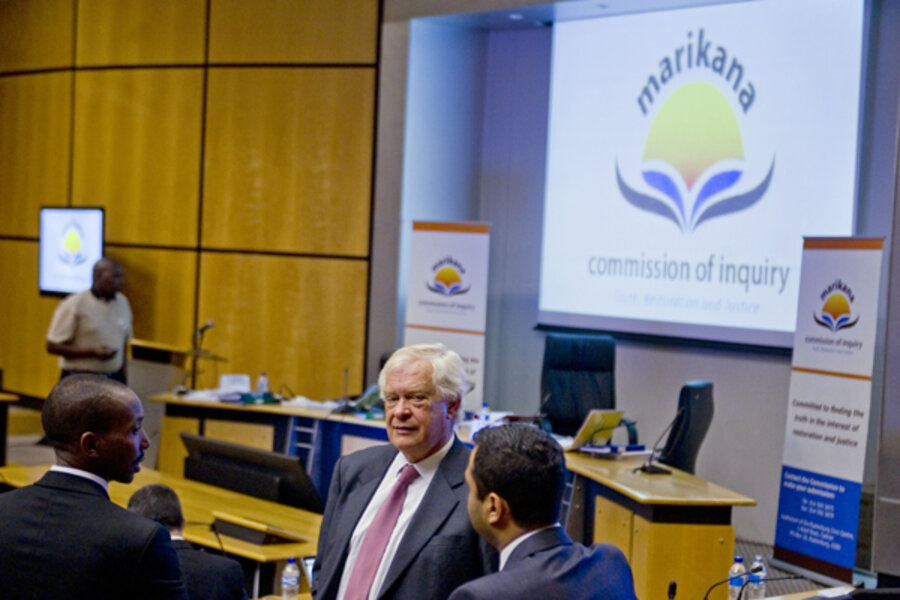South Africa massacre inquiry heightens distrust of police
| Johannesburg
A high profile South African inquiry postponed operations after investigators revealed that police authorities gave false information about circumstances involving the deaths of 44 people during a wildcat strike at a platinum mine last year. For many, the incident has highlighted a culture of police brutality and has become an emotional issue throughout the country.
The Marikana Commission of Inquiry was postponed until next Wednesday, principally after investigators discovered evidence on a police officer's hard drives that had been withheld from the commission, and also found other evidence that was possibly created after the killings to try and manipulate the inquiry. Lead investigator Geoff Budlender told the commission that "some documents have been added and some files we haven't seen before."
The statement, based on the submissions of Mr. Budlender, stated that the South African police version of events is “materially not the truth.”
The South African Police Services (SAPS) issued its own statement by Lt. Gen. Solomon Makgale, calling the bombshell revelation “both unfortunate and highly prejudicial.”
Last August, two officers were brutally killed by miners illegally protesting in a wildcat strike. Some 3,000 workers attended, and eight others were killed. Days later, police opened fire on the miners, killing 34 and injuring 78 in what it claimed was self-defense. About 270 of the miners were arrested and charged with murder, though those were later dropped after a national outcry.
The Aug. 16, 2012, killings at the Wonderkop outcropping outside Marikana sent shock waves through the country, and President Jacob Zuma set up an investigation.
The killings, widely referred to here as a massacre, became a symbol of police excess and violence, and raised fears that violent labor unrest would spread. The area is home to more than one mine and in the past year the area has seen continued violence between mining unions, including several murders.
The new material found on the police officer’s hard drives seems to include files purposefully created during a nine-day conference held by the police to prepare for the inquiry, possibly suggesting a coordinated plan to deceive. According to some local media sources like the Daily Maverick, other evidence includes a video following the killings purportedly showing a police official congratulating his officers on a job well done. The revelations seem likely to further tarnish the public image of the SAPS, which is frequently accused of brutality, corruption, and incompetence.
South Africans and the world were shocked by video captured in the first moments of the strike when it appeared the police were taking an aggressive stance. Criticism escalated when photos emerged suggesting that previously unarmed miners had been photographed next to weapons and lethal instruments after they had been killed off-camera.
No police were arrested in connection with the event.
“First, we have obtained documents which the SAPS previously said were not in existence,” said the commission in the statement. “Second, we have obtained documents which in our opinion ought to have been previously disclosed by the SAPS, but were not so disclosed. Third, we have obtained documents which give the impression that they are contemporaneous documents, but which appear in fact to have been constructed after the events to which they refer,” the statement reads.
“Fourth, we have obtained documents which in our opinion demonstrate that the SAPS version of the events at Marikana, as described in the SAPS presentation to this Commission and in the evidence of SAPS witnesses at this Commission, is in material respects not the truth.”
As public scrutiny intensified following the release of the statement, the Commission tried to clarify that it was the investigators, and not the judges, who had discovered the evidence issues and that despite the very strong wording of the original statement no findings had been made and the judges maintained an open mind.
The commission’s suspension comes on the heels of the annual release of national crime statistics by the national minister of police. The report showed a mixture of positive and negative trends in the nation's crime rates, but also showed the first increase in the nation's murder rate in 10 years.
Riah Phiyega, the national police commissioner, whose tenure of about a year was marked by her perceived failures in effectively handling the Marikana crisis, tried to paint the statistics in a positive light.
The Marikana Commission became politically charged after the miners affected by the killings demanded that the government fund their legal representation before the commission. Some prominent South Africans, including many connected with major opposition parties, joined the cause, staging a major protest march and ratcheting up public pressure.






